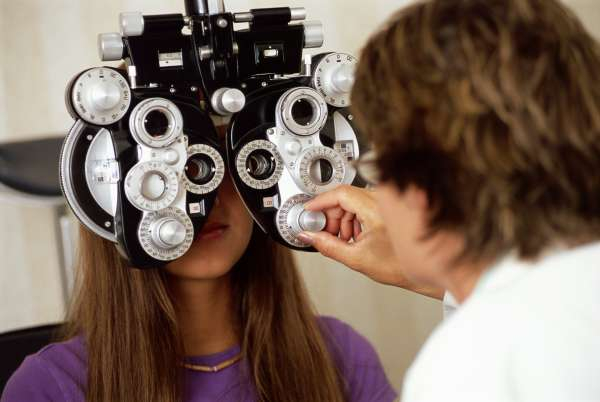
Lasik Procedure
If you’re frustrated with the hassle and limitations of wearing Spectacles or Contact lenses, Refractive surgery could be the solution you’re looking for.
Imagine getting up in the morning and seeing the world clear and sharp from the time you wake up, till the time you go to bed.
LASIK: Short for Laser In-Situ Keratomileusis, this laser eye surgery is used to correct vision in people who are near sighted, farsighted, and/or have astigmatism. During LASIK surgery, vision is corrected by reshaping underlying corneal tissue so that it can properly focus light into the eye and onto the retina. In LASIK eye surgery, a thin flap is made on the outer layer of the cornea so that the underlying tissue can be accessed. LASIK may also be done with the addition of computer imaging called Wave Front Technology to create a detailed image of the cornea and guide for treatment.
LASIK Eye Surgery at VISION 2020 is done on an Allegretto 400Hz Blue Line EYE-Q Laser machine (ALCON) from Germany.
LASIK is a 10 minute surgical procedure performed by an Ophthalmologist. It is intended for correcting the vision in order to reduce a person’s dependency on corrective devices such as Spectacles or Contact Lenses. It is a painless, stitch less surgery.
Different procedures of Lasik:
- Standard
- Customised
- Topographic guided
A person who complaints of blurred vision normally has a refractive error in the eye. Some of them may have Myopia (Short – sightedness), Hypermetropia (Long – sightedness), Astigmatism, or a combination of the above.

The first step in the procedure consists of mapping the corneal surface with a computer controlled scanning device to determine the exact shape. Then the appropriate amount of tissue which needs to be removed is calculated, such that upon replacing the flap there is no need (or less need) for corrective devices like spectacles and lenses.
LASIK is a procedure that permanently changes the shape of the Cornea, the clear covering of the front of the eye, using an excimer laser. When the Cornea is properly reshaped, it will then better focus light onto the Retina. This results in improved vision.
Both near-sighted and far-sighted people can benefit from LASIK.
Before the actual process of conducting the LASIK surgery, the Doctor will have a consultation and examination of your eyes to determine your suitability for the process. This process begins with a discussion regarding what your expectations are and what you wish to achieve by being less dependent or eliminating eyeglasses or contact lenses. Then the Doctor takes a careful review of your health and eye history.
Other types of surgical procedures
- Radial Keratotomy or RK and Photorefractive Keratectomy or PRK, are other procedures used to correct the refractive error, but are now obsolete.
- Later, LASIK was developed, and now it is the most popular and successful technique for correcting refractive errors.
- Next, in order to determine the exact prescription that will need to be treated, a refraction will be performed to measure the amount of near sightedness or farsightedness and astigmatism. This will require the use of eye drops to get the best possible measurements. It is necessary to map the surface of the eye, called the Cornea, with a corneal topographer that gives the Doctor a blueprint of the shape of your eye. An important step is to measure the corneal thickness, called pachymetry, in order to help determine whether the anatomy of your Cornea is appropriate for LASIK or perhaps another laser eye surgery procedure. Once all of these steps have been completed, the Doctor will examine the health of the Retina and inner structure of your eyes as a final check.
- FEMTO LASIK eye surgery is the 100% bladeless approach to traditional LASIK surgery. Instead of using a Microkeratome and blade during the first part of laser eye surgery, the laser uses rapid, predictable pulses of infrared energy, creating a layer of tiny air bubbles within the cornea. The thousands of air bubbles link together to create a bevelled-edge corneal flap, which is then gently pulled back for the second part of the LASIK process. The laser beam never touches the cornea exterior, resulting in fewer complications. The Flap making process takes only seconds, and when it is complete, the second part of the LASIK procedure, correcting the prescription, can continue.
- LASEK: Short for Laser Epithelial Keratomileusis, this is a variant of PRK. An epithelial flap is created and then epithelial cells are loosened using an alcohol solution. A laser is used to reshape the cornea, then the flap is replaced and secured with a soft contact lens while it heals. LASEK surgery is used to treat near sightedness, farsightedness, and astigmatism.
- Intacs: Also known as Intracornial Ring Segments, or ICR, this procedure involves making a small incision in the cornea and placing two crescent-shaped plastic rings at the outer edge or the cornea. The rings flatten the cornea, changing the way light rays focus on the retina. ICR was used to treat mild near sightedness as well as near-sightedness but has been replaced by laser-based procedures. Irregular cornea shape from Keratoconus, a condition that results in vision loss due to thinning and irregularity in the cornea, is the most common condition treated with intacs.
- Phakic intraocular lens implants: Designed for patients who are too near-sighted for LASIK and PRK, the Phakic implant is inserted through a small incision at the edge of the cornea and attached to the iris inserted behind the pupil. This procedure differs from RLE in that the eye’s natural lens is left in place.




